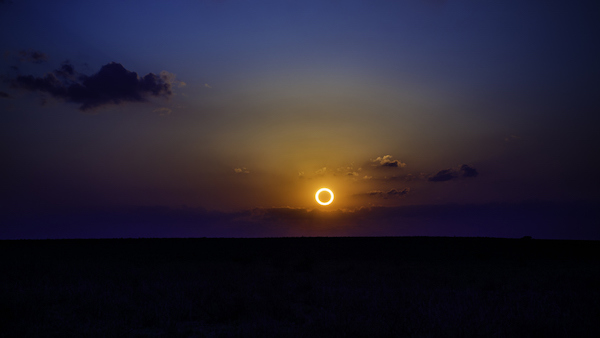Saturday, October 14, will bring a rare astronomical treat to much of North America – an “annular” solar eclipse. Known as the “ring of fire,” the partial solar eclipse will be visible in all 48 contiguous states, along with Alaska. It also marks the last opportunity to witness an annular eclipse in the U.S. until June 21, 2039. Below is everything you need to know about partial solar eclipses and how to safely view the rare event in your part of the country.
What is an Annular Solar Eclipse? An annular solar eclipse occurs when the Moon passes directly between the Earth and Sun, but does not completely cover the Sun’s disk. Instead, it covers most of the Sun, leaving its outer edge visible as a bright ring or “annulus” around the darkened Moon. This is also sometimes referred to as the “Ring of Fire” effect.
Why Aren’t All Solar Eclipses Total Eclipses? The Moon’s orbit around the Earth is not a perfect circle; it’s slightly elliptical. This means that the Moon’s distance from Earth varies throughout its orbit. When the Moon is near its apogee (the farthest point from Earth in its orbit), it appears smaller in the sky. Conversely, when it’s closer to its perigee (the closest point to Earth), it appears larger. During an annular solar eclipse, the Moon moves in front of the Sun at or near apogee. At this distance, it is not large enough from our perspective on Earth to completely cover the Sun. However, during a total solar eclipse, the Moon happens to be in just the right position and just at the right distance from Earth that it exactly covers the relative size of the Sun.
Where Will the October 14 Eclipse Be Visible? The Saturday, Oct. 14, 2023, annular solar eclipse will cross North, Central, and South America. It will be visible in parts of the United States, Mexico, and many countries in South and Central America. For all of that region, the spectacle will be a partial solar eclipse of varying obscuration. Only within the path of annularity, which is 118 to 137 miles wide, will the ring of fire be visible. That path will stretch from Oregon through northern California, northeast Nevada, central Utah, northeast Arizona, southwest Colorado, central New Mexico, and southern Texas. It will then move across the Gulf of Mexico and over Mexico, Guatemala, Belize, Honduras, Nicaragua, Costa Rica, Panama, Colombia and Brazil. The point of the greatest eclipse — where viewers could see a ring of fire lasting 5 minutes, 17 seconds — will occur off the coast of Nicaragua and Costa Rica. Here is what the 10 biggest cities in the U.S. will experience that day; only one will see the ring of fire:
New York: 23% at 1:22 p.m. EDT
Los Angeles: 71% at 9:24 a.m. PDT
Chicago: 43% at 11:58 a.m. CDT
Houston: 85% at 11:58 a.m. CDT
Phoenix: 79% at 9:31 a.m. MST
Philadelphia: 25% at 1:21 p.m. EDT
San Antonio: “Ring of fire” at 11:52 a.m. CDT
San Diego: 68% a.m. at 9:26 PDT
Dallas: 80% at 11:52 a.m. CDT
San Jose, California: 75% at 9:20 a.m. PDT
How to View the Eclipse: The most important factor for eclipse viewing is clear weather. It’s also important to observe the sun safely, meaning you must use solar filters at all times. Whether your location will experience a partial solar eclipse or an annular solar eclipse, the dangers are the same. In fact, a “ring of fire” is technically nothing more than a particularly pretty partial solar eclipse, because at no point will more than 91% of the sun’s disk be covered by the new moon. Observers will need to wear solar eclipse glasses, and cameras, telescopes and binoculars must have solar filters placed in front of their lenses at all times.
When is the Next Eclipse? After the annular solar eclipse on Oct. 14, 2023, the next annular solar eclipse will occur on October 2, 2024, when a ring of fire will be visible from the Pacific Ocean, southern Chile and southern Argentina. Before that, though, there will be a total solar eclipse on April 8, 2024. Learn more at Great American Eclipse HERE. (Sources: Great American Eclipse, Space.com, NASA)










